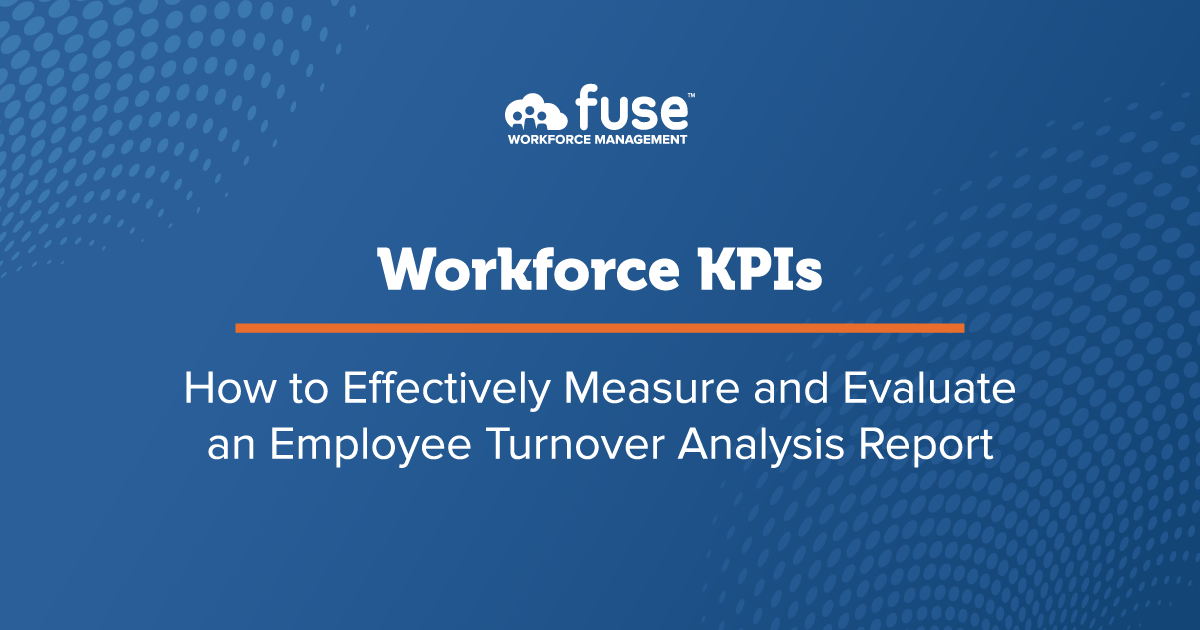Talent retention is a significant concern for organizations, so it's important to understand the causes and effects of employee turnover. The employee turnover rate is based on the number of employees who leave your organization after a specific period.
If employee retention is a priority for your company, an employee turnover analysis report, or headcount report, is a useful tool. There are several ways to measure and evaluate employee turnover. Since hiring – and termination– often falls to the human resource department, HR professionals must understand how to assess and measure the success of their efforts appropriately.
The Importance of Tracking Turnover
It’s a simple fact that employees leave their companies, and transitioning out of an organization is an expected part of the employee lifecycle. These transitions can be for a variety of reasons. Turnover can be voluntary when an employee leaves of their own volition – or involuntary when the company terminates their employment. The turnover rate measures both.
A high turnover rate often indicates issues that would be worth looking into and alerts you to problems that affect your employees. A high voluntary turnover rate means your employees aren't satisfied or happy. Common reasons for high voluntary turnover include management challenges, compensation and benefits, and company culture. High involuntary turnover rates may indicate a need to better screen candidates or communicate roles and responsibilities.
The key takeaway is that you can't fix what you don't know about, so paying attention to those metrics is essential.
Employee turnover is expensive – it costs about one-third of an employee’s annual salary when they leave. Losing employees that required significant training investments may, for example, create a loss. And, of course, hiring is also expensive. According to SHRM, the 2021 average cost-per-hire for a new employee is more than $4,000.
Obviously, if you lose a lot of people, you'll have to spend a lot more money on hiring. If you have a high attrition rate it becomes a vicious cycle – you spend to hire people, pay people, and train people – and if those people leave, it’s a costly loss. So it's definitely important to take them seriously.

The Employee Turnover Rate Formula
The employee turnover rate is not difficult to determine and requires only three pieces of data:
- A specific time period (month, quarter, year, etc.)
- Average number of active employees during the time period
- Total number of terminated employees who left (for any reason) during the time period
Divide the number of terminated employees by the average number of active employees and multiply it by 100 to get your turnover rate.
The Formula in Practice
If you’re trying to see your rate for Q3, you’d look at three months of data.
Let’s say you have 100 employees at the start of Q3. You hire 20 during the quarter, so you end Q3 with 120 employees. The average number of employees is 110. During that time, you also have 8 people leave the company. Using this information, you can find your turnover rate.
Average number of employees Q3 = 110
Number of employees who left during Q3 = 8
Turnover rate: (8/110) x 100 = 7.27
Retention rate: 100 - 7.27 = 92.73
Your turnover rate is 7.27% for Q3 and your retention rate is 92.73%.
This data can be even more useful when broken down into voluntary and involuntary terminations, and if the sample size is large enough, why people left the company, what roles they filled, and even who managed them.
Using Fuse for Employee Turnover Reports
If you are using Fuse Workforce, this information is very easy to get.
Attrition reports are pre-built into the system and are configurable. Fuse automatically calculates the attrition percentage and considers anybody who leaves, retires, or terminates their employment, voluntarily or involuntarily. Reports can be customized to include a variety of different types of data. You can include additional information to make your analysis more thorough, so you can see the rates by state, role, compensation, cost center, or any other item you typically track using Fuse Workforce tools. You could even note if people were terminated due to policy violations or workforce reduction.
If you want to see your turnover statistics and all of the exit interviews that you send out in one custom dashboard, we’ll work with you to create exactly what you need. Alternatively, many human resources professionals utilize multiple tabs on their dashboards, with tabs for attrition, recruitment, and other key information that can live in a time-saving, easy, one-stop area in the dashboard.
The data can also be presented visually with pie charts or column graphs.
For example, you could have a chart showing the number of people who left and why they left, whether it’s a termination for policy violations or voluntary resignations due to the employee finding a better opportunity elsewhere. These easy-to-read, color-coded visual representations can quickly give the viewer a high-level overview of turnover in real-time.
Analyzing Turnover Data
While the retention rate itself provides straightforward insight, it’s most powerful when paired with other data from your business. Together, they can help leadership understand if there are problems and help guide teams as they consider what might be done to improve employee retention.
One place to begin assessing your rate is by finding what’s considered “good” for your type of organization. This varies from industry to industry, sometimes very widely. Utilities average a 6% turnover rate, for example, whereas recent reports show that the hospitality industry in the U.S. has a very high turnover rate of 84.9% right now. You can learn more about what’s normal for your industry by visiting the US Bureau of Labor and the European Union’s Eurostat database for statistics.
If your attrition rate is outside your industry’s norm, it’s worth digging deeper into the causes so they can be fixed. Over time, keeping track of employee turnover data will help you see patterns and establish what’s normal and realistic for your specific company.
Analyzing turnover data provides an excellent opportunity to uncover the root causes. You can pull additional information from productivity metrics, peer feedback, employee surveys, peer stay interviews, and annual reviews. The “bigger picture” is visible when these are combined.
Are many leaving from specific departments? Is it harder to keep someone in a particular job role than others? Are people being terminated for the same reasons over and over again? Once the reasons for turnover are identified, it is important to determine the impact of these reasons on the business. From there, you have the opportunity to make meaningful changes to improve both the bottom line and employee satisfaction.

Improving Your Retention Rate – and Your Organization
As you can see, employee turnover analysis is integral to an organization's ability to thrive and make data-driven decisions. It can be a helpful tool in understanding the strengths and weaknesses of your business. Beyond just reviewing the details to see the attrition rate, a company will ideally use that information to try to better the organization and understand how to best maintain and motivate employees.
If their attrition rate is high, one of the most beneficial things a company could do is assess its employee satisfaction and conduct exit interviews and see why their people are leaving. Maybe it's pay; maybe it's management, maybe it's benefits. Maybe expectations were not aligned. Maybe it's just better opportunities for advancement. Understanding these reasons is vital to creating a plan of improvement, which could include creating a more diverse and inclusive workplace, improving the work environment, or providing training and professional development opportunities.
Turnover analysis can be a helpful tool in understanding the strengths and weaknesses of your business and analyzing how employees are being retained. It may even help you identify what employees may be at risk of leaving and give them good reasons to stay. Finally, sharing the data could help employees understand their importance and how much they matter to your organization.
Ultimately, employee turnover analysis provides an understanding of the reasons for attrition and the key factors that contribute to the success of an organization. The results provide a way for a company to understand what is working for or against it, so you can identify and fix staffing issues and keep your organization meeting its goals.

